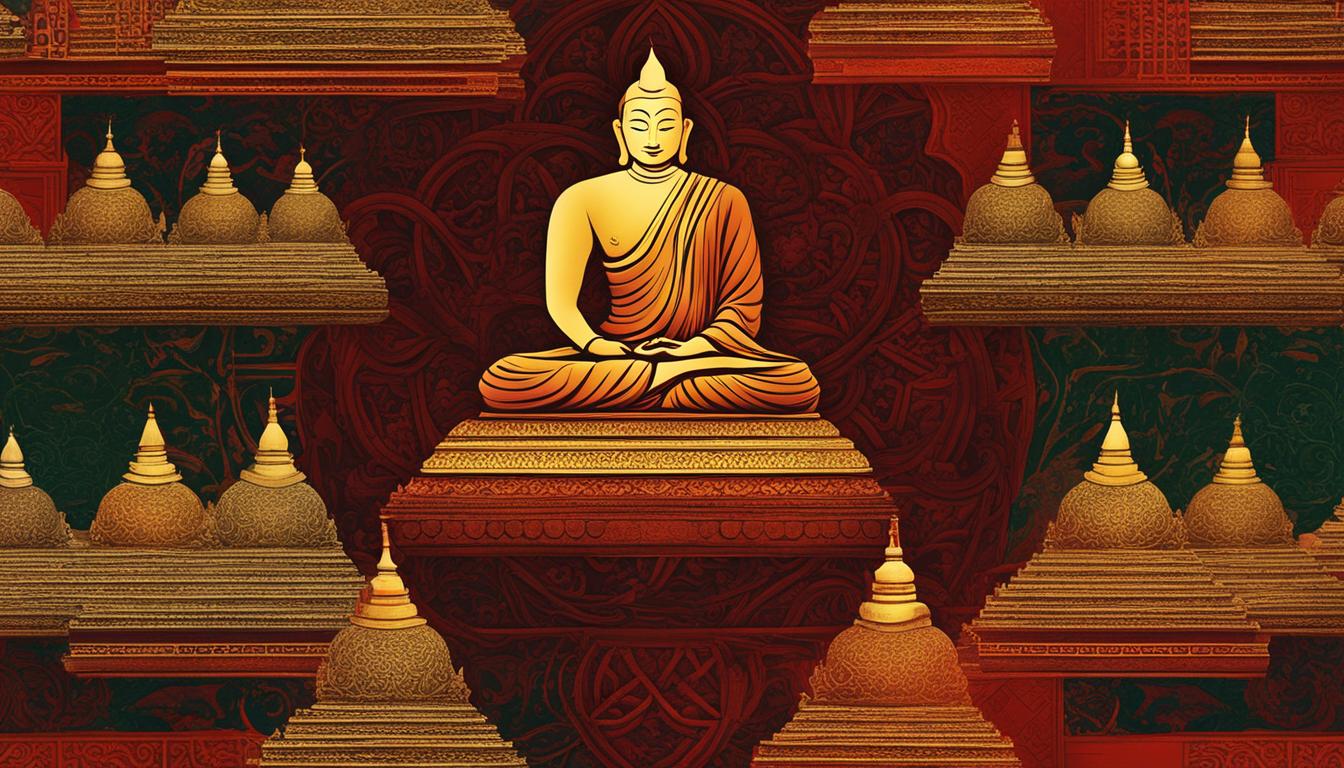In this article, we will explore the key differences between the Jaina Agamas and the Buddhist Pitakas, two important collections of scriptures that form the basis of the Jaina and Buddhist religious traditions. These texts, known as Agamas and Pitakas, respectively, contain the teachings and philosophies that shape the beliefs and practices of their respective religions.
Key Takeaways:
- The Jaina Agamas and Buddhist Pitakas are sacred scriptures that are central to the Jaina and Buddhist religions.
- The Jaina Agamas were codified in Prakrt, while the Buddhist Pitakas were initially composed in Pali.
- The Jaina Agamas focus on principles such as non-violence and asceticism, while the Buddhist Pitakas emphasize the Four Noble Truths and the Middle Way.
- Both the Jaina Agamas and Buddhist Pitakas have had a significant influence on the religious practices and cultural traditions of their respective communities.
- The Jaina Agamas and Buddhist Pitakas continue to play a vital role in the religious lives of Jains and Buddhists, respectively.
Historical Background and Development
The Jaina Agamas and Buddhist Pitakas have their origins in the teachings of two prominent ancient religious figures: Lord Mahavir, the 24th Tirthankara of Jainism, and Gautama Buddha, the founder of Buddhism. Both these spiritual leaders laid the foundation for their respective belief systems and left behind a rich legacy of teachings and scriptures.
The Jaina Agamas, which form the sacred texts of Jainism, were codified by Lord Mahavir’s disciples into the Prakrt language, primarily Ardhamagadhi. These texts underwent a process of compilation to ensure their preservation and dissemination. On the other hand, the Buddhist Pitakas contain the sermons and teachings of Gautama Buddha. Initially composed in Pali, a language accessible to the common people, the Pitakas also underwent the process of codification and compilation by trusted disciples.
The historical background and development of the Jaina Agamas and Buddhist Pitakas play a crucial role in understanding the evolution and significance of these scriptures within their respective religious traditions.
Table: Comparison of Historical Background and Development
| Jaina Agamas | Buddhist Pitakas | |
|---|---|---|
| Founder | Lord Mahavir | Gautama Buddha |
| Language | Prakrt (Ardhamagadhi) | Pali |
| Codification | By Lord Mahavir’s disciples | By trusted disciples of Gautama Buddha |
| Purpose | To preserve and disseminate Jain teachings | To preserve and disseminate Buddhist teachings |
Doctrines and Beliefs
The Jaina Agamas and Buddhist Pitakas have distinct doctrines and beliefs that form the core of their respective religious traditions. These scriptures provide guidance on how to live a virtuous life and attain spiritual liberation.
Jaina Agamas
The Jaina Agamas expound on several key principles, including non-violence (ahimsa), multiple perspectives (anekantavada), non-attachment (aparigraha), and asceticism. Ahimsa is the practice of non-violence towards all living beings and is considered essential for attaining spiritual enlightenment. Anekantavada promotes the acceptance of multiple viewpoints and encourages individuals to consider different perspectives in their pursuit of truth. Aparigraha teaches the importance of non-attachment to material possessions, emphasizing the need to overcome desire and attachment to achieve liberation. Asceticism, through self-discipline and renunciation, is seen as a means to detach from worldly distractions and focus on spiritual growth.
Buddhist Pitakas
The Buddhist Pitakas emphasize the Four Noble Truths, the Eightfold Path, and the Middle Way as the central teachings of Buddhism. The Four Noble Truths state that suffering exists, suffering arises from craving, suffering can be overcome, and the Eightfold Path is the way to end suffering. The Eightfold Path consists of right view, right intention, right speech, right action, right livelihood, right effort, right mindfulness, and right concentration. The Middle Way teaches the importance of avoiding extremes and finding balance in all aspects of life. Buddhism also emphasizes the doctrines of impermanence and no-self (anatta), which challenge the notion of a permanent, independent self.
| Jaina Agamas | Buddhist Pitakas |
|---|---|
| Teachings of non-violence (ahimsa) | Emphasis on the Four Noble Truths |
| Emphasis on multiple perspectives (anekantavada) | Guidance on the Eightfold Path |
| Teachings on non-attachment (aparigraha) | Emphasis on the Middle Way |
| Emphasis on asceticism | Teachings on impermanence and no-self (anatta) |
These doctrines and beliefs shape the religious practices and ethical principles followed by Jains and Buddhists, respectively.
Scriptural Language
The Jaina Agamas and Buddhist Pitakas, being ancient collections of scriptures, were originally written in specific languages that were chosen to make the teachings accessible to the common people. The Jaina Agamas were written in Prakrt, specifically Ardhamagadhi, while the Buddhist Pitakas were composed in Pali. Both languages were widely spoken during the time of their respective religions’ founding figures, Lord Mahavir and Gautama Buddha, making them suitable for the dissemination of their teachings.
Use of Regional Languages for Wider Reach
In addition to Prakrt and Pali, translations and commentaries of the Jaina Agamas and Buddhist Pitakas were eventually produced in other languages, such as Sanskrit and various regional languages. This allowed for a wider dissemination of the scriptures beyond the original languages and facilitated the spread of Jainism and Buddhism to different regions.
Cultural and Linguistic Influence
The choice of scriptural languages has had a profound impact on the cultural and linguistic development of Jainism and Buddhism. The Jaina Agamas, written in Prakrt, contributed to the preservation and evolution of Prakrt as a language. Similarly, the Buddhist Pitakas played a significant role in the development and propagation of Pali as a literary language. The influence of these languages can be observed not only in religious practices but also in various artistic expressions, literature, and linguistic variations within Jain and Buddhist communities.
Divisions and Compilation
Both the Jaina Agamas and Buddhist Pitakas are extensive collections of scriptures, each with its own unique divisions and organization. Let’s explore the divisions and compilation methods of these sacred texts:
Jaina Agamas
The Jaina Agamas are classified into various categories that provide a comprehensive understanding of Jain teachings. These categories include the 12 Angas, which cover the fundamental principles and doctrines of Jainism, and the 12 Upangas, which delve deeper into specific topics. Additionally, the 4 Mulas serve as foundational texts, outlining the basic teachings of the Jaina philosophy. Alongside these categories, there are several other texts that provide further insights into various aspects of Jainism.
Buddhist Pitakas
The Buddhist Pitakas, on the other hand, are divided into three main sections, each addressing different aspects of Buddhism. The Vinaya Pitaka focuses on the rules and guidelines for monastic discipline, ensuring the proper conduct of Buddhist monks and nuns. The Sutta Pitaka contains a vast collection of discourses given by Gautama Buddha, covering a wide range of topics such as ethics, meditation, and wisdom. Lastly, the Abhidhamma Pitaka provides a detailed analysis of Buddhist philosophy, exploring the nature of mind, consciousness, and reality.
| Jaina Agamas | Buddhist Pitakas |
|---|---|
| 12 Angas | Vinaya Pitaka |
| 12 Upangas | Sutta Pitaka |
| 4 Mulas | Abhidhamma Pitaka |
| Various other texts |
The compilation of these scriptures involved the dedicated efforts of trusted disciples who meticulously preserved and documented the teachings of their respective religious leaders. The divisions within the Agamas and Pitakas allow for easy access to specific teachings and help followers navigate the vast corpus of knowledge contained within these ancient texts.
Overall, the divisions and compilation methods of the Jaina Agamas and Buddhist Pitakas have played a crucial role in preserving and disseminating the teachings of Jainism and Buddhism, respectively. These scriptures continue to be revered by followers of both traditions, serving as guiding lights on their spiritual journey.
Religious Practices and Traditions
The Jaina Agamas and Buddhist Pitakas not only provide spiritual teachings and philosophical insights but also serve as a guide for the religious practices and traditions followed by their respective communities.
In Jainism, the Agamas form the basis for various religious rituals and observances. The Five Great Vows (Mahavratas) are central to Jain practice and include non-violence, truthfulness, non-stealing, celibacy, and non-attachment. Jains also engage in daily prayers, meditation, and the recitation of sacred texts. Pilgrimage to important Jain sites, such as Shikharji and Palitana, is considered a significant practice for spiritual growth and enlightenment.
Similarly, Buddhism places emphasis on ethical conduct and meditation. The Buddhist Pitakas outline the Eightfold Path, which encompasses right understanding, right thought, right speech, right action, right livelihood, right effort, right mindfulness, and right concentration. Monasticism plays a crucial role in Buddhist practice, with monastics observing strict discipline and engaging in meditation retreats. Important Buddhist festivals, such as Vesak and Magha Puja, are celebrated by Buddhists worldwide.
Table: Comparison of Religious Practices and Traditions
| Jaina Agamas | Buddhist Pitakas |
|---|---|
| Observance of Five Great Vows | Emphasis on ethical conduct |
| Daily prayers and recitation of scriptures | Meditation practices |
| Pilgrimage to sacred Jain sites | Observance of important Buddhist festivals |
| Ascetic practices | Role of monasticism |
These religious practices and traditions not only provide a framework for spiritual growth but also foster a sense of community and shared values among Jains and Buddhists. They serve as a means to develop discipline, cultivate virtues, and attain higher states of consciousness. Through these practices, followers of Jainism and Buddhism strive to align their lives with the teachings of their respective scriptures and attain enlightenment.
Significance and Influence
The Jaina Agamas and Buddhist Pitakas hold immense significance within their respective religious traditions and have exerted a profound influence on the development of Jainism and Buddhism. These sacred scriptures serve as the bedrock of spiritual teachings, guiding the beliefs, practices, and ethical principles of their followers.
Jaina Agamas
The Jaina Agamas are highly revered by Jains and play a central role in shaping their religious and cultural identity. These scriptures outline the fundamental doctrines of Jainism, emphasizing concepts such as non-violence, multiple perspectives, non-attachment, and asceticism. The Agamas provide a comprehensive framework for leading a virtuous and disciplined life, with the ultimate goal of attaining spiritual liberation. They have been instrumental in preserving and transmitting the rich heritage of Jain traditions from one generation to the next.
Buddhist Pitakas
The Buddhist Pitakas are of paramount importance within Buddhism and have had a lasting impact on the development of various Buddhist schools and sects. These scriptures lay out the teachings of Gautama Buddha, focusing on key principles such as the Four Noble Truths, the Eightfold Path, and the Middle Way. Additionally, the Pitakas delve into the profound concepts of impermanence and no-self. Their influence extends beyond religious practices and has permeated into various aspects of Buddhist societies, including cultural practices, literature, and art forms.
Overall, the Jaina Agamas and Buddhist Pitakas hold great significance as sacred texts that serve as guides for the beliefs, practices, and ethical principles of Jainism and Buddhism. Their deep-rooted influence continues to shape the spiritual lives of their respective followers and contributes to the rich heritage and traditions of these ancient religions.

Conclusion
In conclusion, the Jaina Agamas and Buddhist Pitakas are significant collections of scriptures that embody the teachings and doctrines of Jainism and Buddhism, respectively. These sacred texts play a vital role in the religious lives of their respective followers, guiding their beliefs, practices, and ethical principles.
While the Jaina Agamas and Buddhist Pitakas share some common principles, such as the importance of non-violence, they also have distinct beliefs, practices, and historical development that distinguish them from each other. The Agamas emphasize non-attachment, multiple perspectives, and asceticism, while the Pitakas emphasize the Four Noble Truths, the Eightfold Path, and the Middle Way.
Both the Jaina Agamas and Buddhist Pitakas contribute to the rich spiritual traditions of Jainism and Buddhism, shaping the religious and cultural identity of their respective communities. These scriptures have not only guided the lives of millions of individuals but have also influenced a wide range of cultural practices, literature, and art forms in Jain and Buddhist societies throughout history.
FAQ
What are the Jaina Agamas and Buddhist Pitakas?
The Jaina Agamas are the sacred texts of Jainism, while the Buddhist Pitakas serve as the scriptures of Buddhism. These texts contain the teachings and doctrines that form the foundation of each respective belief system.
Who were the founders of Jainism and Buddhism?
Lord Mahavir is considered the 24th Tirthankara and founder of Jainism, while Gautama Buddha is the founder of Buddhism.
What are the main principles emphasized in the Jaina Agamas and Buddhist Pitakas?
The Jaina Agamas focus on non-violence, multiple perspectives, non-attachment, and asceticism. The Buddhist Pitakas emphasize the Four Noble Truths, the Eightfold Path, and the Middle Way.
In which languages were the Jaina Agamas and Buddhist Pitakas originally composed?
The Jaina Agamas were written in Prakrt, specifically Ardhamagadhi, while the Buddhist Pitakas were initially composed in Pali.
What is the division and compilation of the Jaina Agamas and Buddhist Pitakas?
The Jaina Agamas are classified into categories such as the 12 Angas, 12 Upangas, and 4 Mulas. The Buddhist Pitakas are divided into the Vinaya Pitaka, Sutta Pitaka, and Abhidhamma Pitaka.
How do the Jaina Agamas and Buddhist Pitakas influence religious practices and traditions?
The Jaina Agamas form the basis for Jain religious practices, such as the observance of the Five Great Vows and pilgrimage to sacred sites. The Buddhist Pitakas provide guidelines for ethical conduct, meditation practices, and the role of monasticism in Buddhism.
What is the significance of the Jaina Agamas and Buddhist Pitakas?
The Jaina Agamas are regarded as sacred texts that guide the beliefs, practices, and ethical principles of Jainism, while the Buddhist Pitakas serve as the foundation of Buddhist teachings and have had a profound impact on Buddhist schools, sects, and cultural practices.
 Skip to main content
Skip to main content


